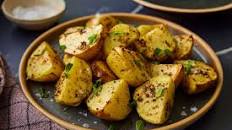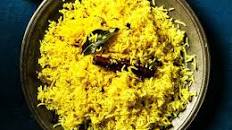Savoury Delights: Exploring Divine Potato Recipes for Every Palate

The Versatile Spud: Exploring Delicious Potato Recipes
Potatoes are a staple ingredient in many cuisines around the world, beloved for their versatility and ability to be transformed into a wide array of mouth-watering dishes. Whether mashed, roasted, or fried, potatoes never fail to satisfy our cravings for comfort food. Let’s delve into some delightful potato recipes that are sure to tantalise your taste buds.
Classic Roast Potatoes
To make the perfect roast potatoes, start by parboiling peeled and chopped potatoes until slightly tender. Drain and toss them in hot oil, then roast in the oven until crispy on the outside and fluffy on the inside. Season with salt, pepper, and herbs for a delectable side dish.
Creamy Mashed Potatoes
For creamy mashed potatoes, boil peeled potatoes until soft, then mash them with butter, milk, and seasoning until smooth and velvety. Top with a dollop of butter and fresh chives for an indulgent treat that pairs well with any main course.
Crispy Potato Rosti
Rosti is a Swiss dish made from grated potatoes that are pan-fried until golden and crispy. Add grated cheese or onions for extra flavour, then serve as a savoury breakfast or as a satisfying side dish alongside meats or salads.
Potato Gnocchi
Gnocchi are soft dumplings made from mashed potatoes, flour, and egg. These pillowy delights can be served with rich tomato sauce, creamy pesto, or browned butter for a comforting meal that is both simple and elegant.
Spicy Potato Wedges
Toss thick potato wedges in a mixture of spices like paprika, garlic powder, and cayenne pepper before baking them in the oven until crispy and golden brown. These spicy potato wedges make a delicious snack or side dish for any occasion.
Whether you prefer your potatoes roasted to perfection or mashed to creamy goodness, there is no shortage of delightful recipes to explore with this humble yet versatile vegetable. Get creative in the kitchen and discover new ways to enjoy the humble spud!
9 Essential Tips for Mastering Potato Recipes in the Kitchen
- Boil potatoes with their skin on to retain more nutrients.
- For crispy roast potatoes, parboil them before roasting.
- Use a mandoline slicer for evenly sliced potato gratin or chips.
- Add a pinch of turmeric when boiling potatoes for a vibrant colour.
- Incorporate mashed potatoes into bread dough for soft and fluffy bread rolls.
- Store raw potatoes in a cool, dark place to prevent sprouting.
- Make a creamy potato salad by mixing mayo with Dijon mustard and fresh herbs.
- Try making hassleback potatoes by thinly slicing them without cutting all the way through before baking.
- Experiment with different potato varieties like sweet potatoes or purple potatoes for unique dishes.
Boil potatoes with their skin on to retain more nutrients.
Boiling potatoes with their skin on is a simple yet effective tip to retain more nutrients in this versatile vegetable. The skin acts as a natural barrier, preventing water-soluble vitamins and minerals from leaching out during the cooking process. By keeping the skin intact, you preserve essential nutrients such as vitamin C, potassium, and fibre, ensuring that your potato dishes are not only delicious but also packed with goodness. So next time you prepare a potato recipe, consider leaving the skin on for an extra nutritional boost.
For crispy roast potatoes, parboil them before roasting.
For achieving perfectly crispy roast potatoes, a key tip is to parboil them before placing them in the oven. By partially cooking the peeled and chopped potatoes in boiling water, they become slightly tender, which helps create a crispier exterior when roasted. This method allows the potatoes to develop a golden and crunchy crust while remaining fluffy on the inside, resulting in a delightful texture that enhances the overall flavour of the dish.
Use a mandoline slicer for evenly sliced potato gratin or chips.
When preparing potato gratin or chips, a useful tip is to utilise a mandoline slicer for achieving uniformly sliced potatoes. The mandoline slicer ensures that each potato slice is of consistent thickness, leading to even cooking and a beautifully layered gratin or perfectly crispy chips. This handy kitchen tool not only saves time but also enhances the presentation and texture of your potato dishes, allowing you to create culinary delights that are both visually appealing and delicious.
Add a pinch of turmeric when boiling potatoes for a vibrant colour.
Enhance the visual appeal of your potato dishes by incorporating a simple yet effective tip: adding a pinch of turmeric to the boiling water. This small addition not only infuses the potatoes with a subtle earthy flavour but also imparts a vibrant golden hue to them. The result is not only visually striking but also adds an extra layer of depth to your culinary creations. Try this trick next time you boil potatoes for a colourful and appetising twist to your favourite recipes.
Incorporate mashed potatoes into bread dough for soft and fluffy bread rolls.
Elevate your bread-making game by incorporating mashed potatoes into your dough for irresistibly soft and fluffy bread rolls. The addition of mashed potatoes not only enhances the texture of the bread but also adds a subtle sweetness and richness that will take your homemade rolls to the next level. The result is a batch of freshly baked bread rolls that are tender, moist, and simply delicious. Give this tip a try to experience the delightful difference that mashed potatoes can make in your baking creations.
Store raw potatoes in a cool, dark place to prevent sprouting.
To ensure the longevity and quality of your raw potatoes, it is recommended to store them in a cool, dark place to prevent sprouting. Exposing potatoes to light can trigger the growth of unsightly sprouts, affecting their taste and texture. By keeping them in a cool and dark environment, such as a pantry or cellar, you can help maintain the freshness of your potatoes for longer periods, ensuring that they remain perfect for your delicious potato recipes.
Make a creamy potato salad by mixing mayo with Dijon mustard and fresh herbs.
Elevate your potato salad game by creating a creamy and flavourful dish with a simple twist. Combine mayonnaise with tangy Dijon mustard and fragrant fresh herbs to infuse your potato salad with a deliciously rich and zesty dressing. This combination adds a depth of flavour that complements the soft texture of the potatoes, resulting in a refreshing and satisfying side dish that is perfect for picnics, barbecues, or any meal where you want to impress with a classic favourite reinvented.
Try making hassleback potatoes by thinly slicing them without cutting all the way through before baking.
For a unique twist on potato recipes, consider trying hassleback potatoes. This method involves thinly slicing the potatoes without cutting all the way through, creating a accordion-like effect. By baking these sliced potatoes, you achieve a crispy exterior while keeping the inside soft and fluffy. The hassleback technique not only enhances the presentation of the dish but also allows for a delightful blend of textures and flavours in every bite. Give this creative approach a go to elevate your potato game and impress your guests with a visually stunning and delicious side dish.
Experiment with different potato varieties like sweet potatoes or purple potatoes for unique dishes.
When exploring potato recipes, consider experimenting with various potato varieties, such as sweet potatoes or purple potatoes, to add a unique twist to your dishes. Sweet potatoes offer a naturally sweet flavour and are packed with nutrients, making them a versatile ingredient in both savoury and sweet recipes. Purple potatoes, on the other hand, bring vibrant colour and a slightly nutty taste to dishes, adding visual appeal and an interesting flavour profile. By incorporating different potato varieties into your cooking, you can create innovative and exciting dishes that showcase the diverse possibilities of this humble vegetable.

